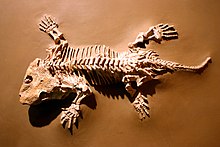| Seymouriamorpha Temporal range: Late Carboniferous - Late Permian | |
|---|---|

| |
| Fossil of Seymouria in the National Museum of Natural History | |
| Scientific classification | |
| Domain: | Eukaryota |
| Kingdom: | Animalia |
| Phylum: | Chordata |
| Clade: | Reptiliomorpha (?) |
| Order: | †Seymouriamorpha Watson, 1917 |
| Subgroups | |
Seymouriamorpha were a small but widespread group of limbed vertebrates (tetrapods). They have long been considered stem-amniotes (reptiliomorphs), and most paleontologists still accept this point of view, but some analyses suggest that seymouriamorphs are stem-tetrapods (not more closely related to Amniota than to Lissamphibia).
Many seymouriamorphs were terrestrial or semi-aquatic. However, aquatic larvae bearing external gills and grooves from the lateral line system have been found, making them unquestionably non-amniotes. As they matured, they became more terrestrial and reptile-like. They ranged from 30 cm (1 ft) long lizard-sized creatures to the 1.5 m (5 ft) long Enosuchus. If seymouriamorphs are reptiliomorphs, they were the distant relatives of amniotes.
Seymouriamorphs are divided into three main groups: Kotlassiidae, Discosauriscidae, and Seymouriidae, which includes the best-known genus, Seymouria. The last seymouriamorphs became extinct by the end of the Permian.
Taxonomy
- Biarmica
- Enosuchus
- Kotlassia
- Leptoropha
- Microphon
- Nyctiboetus
- Utegenia
- Waggoneria
- Family Karpinskiosauridae
- Family Discosauriscidae
- Family Seymouriidae
Cladogram based on Ruta, Jeffery, & Coates (2003):
| Seymouriamorpha |
| ||||||||||||||||||||||||||||||||||||
Cladogram based on Klembara (2009) & Klembara (2010):
| Seymouriamorpha |
| ||||||||||||||||||||||||||||||||||||
Gallery
References
- Klembara, J.; Werneburg, R.; Mikudíková, M.; Šurka, J.; Štamberg, S. (2023). "The oldest records of the stem amniote Discosauriscus (Seymouriamorpha, Discosauriscidae) from the European Carboniferous-Permian boundary". Bulletin of Geosciences. 98 (3): 233–246. doi:10.3140/bull.geosci.1882.
- Laurin, Michel (2010). How Vertebrates Left the Water. Berkeley: University of California Press. ISBN 978-0-520-26647-6.
- Bulanov VV (2003). "Evolution and systematics of seymouriamorph parareptiles". Paleontological Journal. 37 (Supplement 1): 1–105.
- Olson, E. C. (1951). "Fauna of upper Vale and Choza: 1-5" (PDF). Fieldiana Geology. 10 (11): 89–128. doi:10.5962/bhl.title.3264.
- Ruta, M.; Jeffery, J. E.; Coates, M. I. (2003). "A supertree of early tetrapods". Proceedings of the Royal Society B. 270 (1532): 2507–16. doi:10.1098/rspb.2003.2524. PMC 1691537. PMID 14667343.
- Klembara, Jozef (2009). "The skeletal anatomy and relationships of a new discosauriscid seymouriamorph from the lower Permian of Moravia (Czech Republic)". Annals of Carnegie Museum. 77 (4): 451–483. doi:10.2992/0097-4463-77.4.451.
- Klembara, Jozef (2011). "The cranial anatomy, ontogeny, and relationships of Karpinskiosaurus secundus (Amalitzky) (Seymouriamorpha, Karpinskiosauridae) from the Upper Permian of European Russia" (PDF). Zoological Journal of the Linnean Society. 161 (1): 184–212. doi:10.1111/j.1096-3642.2009.00629.x.
External links
- Bystrow, A.P. Kotlassia prima Amalitzky. Bulletin of the Geological Society of America, Washington, 1944, v.55, N5, pp.379-416.
- Seymouriamorpha - at Paleos
- Seymouriamorpha at Tree of Life Web Project
| Reptiliomorpha (Pan‑Amniota) | |||||||||||||
|---|---|---|---|---|---|---|---|---|---|---|---|---|---|
| |||||||||||||
| Taxon identifiers | |
|---|---|
| Seymouriamorpha | |

